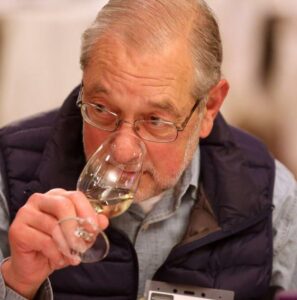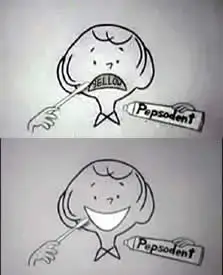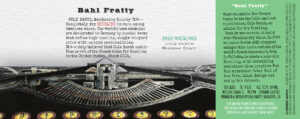
Dan Berger was born in Brooklyn and attended New York public schools as a child. Even then, he was no stranger to the sound of printing the news, as his grandfather had a shop with a noisy hand-operated printing press. Their family moved to the Los Angeles area before Dan started high school. His parents gave him a manual typewriter as a graduation gift because they thought he was a good writer. Dan was fascinated with words and what makes things work, and he also spent time playing chess and singing in a barbershop quartet. He studied math in college, and following some challenging classes, switched gears to major in journalism. After landing a job as a journalist he covered everything from sports, weather, news headlines, business, and ultimately food and wine. Here’s his story.
You were born in Brooklyn and lived there for the first few years of your life. Tell us what you remember of your NY home and early family life, any siblings you have, and whether wine played a role at the family table.
I was only seven when we moved. My father and mother owned a retail store that mainly sold toys, books, greeting cards, and office supplies. Our apartment was above our store, on the second level. I had two younger brothers, and attended school from ages 5 to 7 at a New York public school. My grandfather lived a few blocks away. He ran a print shop, with a very noisy hand-fed press. I particularly remember the snowy winters, the fact that we heated our home by coal that was delivered by a truck with a ramp into our basement, and the coal was shoveled into the furnace.
Your parents moved the family from Brooklyn to Southern California in 1949. Why did they do so?
There were personal reasons why we made the move, but the winter of 1948 was particularly cold and my parents believed the West Coast was a better place to raise children. My father flew out to California, bought a business and a house, and came back and we packed up. We took the train through Chicago and into Los Angeles, and we moved into a small, three-bedroom house. A few years later, we moved to Hollywood. My father’s stationery store was within a block of CBS Television City and we had opportunities to meet several famous people.
Do you recall being uprooted and how that impacted your life as a young boy? Were you excited about the move?
Since I was only seven at the time, I really didn’t have very many friends that I was ultimately going to miss. Since I was born during World War II, we had no car and therefore I didn’t see my cousins all that much. The move was really interesting, primarily from a curiosity point of view, because I figured out pretty quickly that this was a permanent move. I didn’t know anything about California, but my parents were extremely pleased to have made this pretty courageous move.
You graduated from Fairfax High School in Los Angeles County, and while a student you sang in a barbershop quartet and performed at the Hollywood Bowl.
I sang in my high school’s a cappella choir and at Christmas time one year, my choir director asked me if I could sing the Messiah at Amy Semple McPherson’s church. I was a bass and the choir didn’t have a bass. I agreed and sang the Messiah there for four consecutive Christmases.
I had always been a very good chess player, and I joined the chess club in high school and eventually became the Los Angeles city champion in chess. My father was in love with barbershop quartet singing (he formed a small group called the Astronotes), so when I found out about the Los Angeles City High School barbershop quartet competition, I formed a small group with three guys. We called ourselves the Four Fs, a play on the phrase used for someone who is unacceptable for military duty.
Did you ever consider a career as a singer or musician? Do you still sing (or only in the shower)?
I loved choral music, so when I went to UCLA, I joined the choir there, which was conducted by Roger Wagner, who also had the famed Roger Wagner Chorale. He, too, needed singers for his “B” group. (The A group did recordings and special appearances.) Since I was in the B group, we got to perform at the Hollywood Bowl, Pasadena Civic Auditorium, and other such venues.
Who is your all-time favorite singer and what song moves you the most?
Popular singers really never excited me. It is choral music that I like the most.
You earned a degree in Journalism at Cal State. What motivated you to become a journalist?
I was a mathematics major at UCLA but had difficulty with a couple of classes. I was always a very good writer, in fact on my graduation from high school, my parents gave me a portable typewriter because they believed that I could have a career in writing.
After the math opportunities didn’t work out, I decided to get a degree in journalism, but UCLA did not have that course of study for an undergraduate degree. So I transferred to Cal State LA to get that journalism degree.
I have always been fascinated with knowing stuff. I always wondered why things were the way they were. I learned a lot by reading nonfiction. lthough I have read lots of novels, nonfiction has always been far more interesting to me than fiction. I used to play a lot of chess in tournaments, and to keep my mind occupied while I waited for my opponent to make his move, I often read nonfiction, like Karl Marx’s Communist Manifesto, and Jean-Paul Sartre, and articles about the U.S. Supreme Court.
From around 1983 through 1986, I was a high-technology reporter for the San Diego Union; the reason I loved the job so much was that it taught me that curiosity can lead to enlightenment. It was the most enjoyable job I ever had. I was really sad to leave that position.
You have one of the widest vocabularies of any wine writer. When reading your articles it’s good to have a dictionary at hand to look up the meanings of some of the words you use! How do you manage to include so many diverse and unusual words? Do you challenge yourself to do this?
 Most of my vocabulary was fostered by my parents and my two brothers. We had an astoundingly dynamic family life, with amazing discussions around the dinner table. Both my parents attended college, even though it was the depression; both my father and mother entered contests, which were not sweepstakes, but contests in which you had to write clever sayings, name certain products, or come up with slogans for products. They also wrote greeting card rhymes that they sold to the greeting card companies at $.25 per line. Some of the contests were amazing. My parents won $25,000 in the 1960s by writing a 25-word statement to answer the question, “Where did the yellow go when you brush your teeth with Pepsodent?”
Most of my vocabulary was fostered by my parents and my two brothers. We had an astoundingly dynamic family life, with amazing discussions around the dinner table. Both my parents attended college, even though it was the depression; both my father and mother entered contests, which were not sweepstakes, but contests in which you had to write clever sayings, name certain products, or come up with slogans for products. They also wrote greeting card rhymes that they sold to the greeting card companies at $.25 per line. Some of the contests were amazing. My parents won $25,000 in the 1960s by writing a 25-word statement to answer the question, “Where did the yellow go when you brush your teeth with Pepsodent?”
I believe many writers understand a problem we all face: A writer may find his or her subject to be interesting, even compelling, but the reader’s interest might flag at some point. One way to enliven articles is to use some interesting verbiage and/or double entendres and other wordplay. It also helps to break up phrases in which the same word might show up two or even three times.
During your early career as a journalist, you covered general news and sporting events, and in 1972 you were sent to Munich to cover the track and field events at the Olympics. You’ve also covered major events such as the kidnapping of Patty Hearst. How did you manage to get these assignments in a competitive pool of reporters?
When I joined the Associated Press (AP), I did not have much of a specialty and was happy to work on virtually anything. Sports was easy, and since no one else wanted to do it, I was happy to accommodate the editors. One of the things that I did to challenge myself was to spice up my writing a little more because AP had been considered to be the wire service that was more specific to factual material, and our rival, UPI, was considered to be more “writerly.” So, I always found that using alliteration, and other such verbal tweaks created more of a likelihood that the reader would actually read the article.
I worked the night shift for many years, and one of the first things that was required in the AP office was to write the daily weather story, which in Los Angeles was about as boring an article as anyone could ever imagine. No one in the office ever wanted to write it. I found that it was quite a challenge, and it gave me unbelievable opportunities to become ridiculously creative. Sometimes the weather story was silly and completely out of character for the company. But my editors were thrilled that somebody was willing to write it without complaint.
So, all the other assignments that I got were the result of other people preferring to sit on broken chairs at broken typewriters. I loved the challenge of getting out and doing stuff that was atypical of the company. My favorite story of all time was covering a plane crash in American Samoa. It took me more than six months before I was able to nail that story down!
After a lot of late-night suppers with colleagues who favored meat, potatoes, and beer, we heard that you convinced some to join you for a change to a meal with seafood and wine. Were you already a wine aficionado and Riesling lover at that time? Was that the experience that changed the course of your career, from focusing on sports to writing about wine?
I was already a wine lover but didn’t know anything about it. At all. I was covering the Olympic Games track and field trials in Eugene, Oregon. It was a 10-day event, and every day ended at around 10 PM with all the writers finally filing their stories to their newspapers. I was AP’s national track and field correspondent and considered to be the encyclopedia of track and field, so even if I finished my story early, I stayed in the stadium to wait until everybody was finished, as a fact-checker.
Night after night we would go to a local steakhouse, mainly because it was the only place that was left open in Eugene, Oregon. I was bored with steak and beer. On the Saturday night you referred to, the Hotel Eugene’s kitchen was open later than usual, so an L.A. Times reporter and I went to the hotel. I ordered a fillet of sole and a bottle of Riesling. The wine came to the table and I thought it was spoiled, but didn’t know what I was doing until the waiter smelled my glass and said, “Sir, this wine is corked.” He brought another, which was fine, and then said, “you might have a career in the wine business.”
In 1988 you took a position as a wine columnist with the Los Angeles Times. How did that come about, and what is your favorite experience while serving in that role?
In 1987 David Shaw, the late media critic for the L.A. Times, wrote an exposé about wine writers in the United States who were “on the take,” and expected to get free cases of wine for writing favorable articles. That led to the firing of one Los Angeles Times wine writer, and the paper went looking for a replacement. I had been writing a syndicated wine column since 1979 for Copley News Service as well as for the San Diego Union, and had already moved to Santa Rosa to become business editor for the Santa Rosa Press Democrat. When the L.A. Times called and offered me the position, I had to resolve living in Los Angeles part-time and living in Santa Rosa part-time. The Times was amazingly flexible and it worked out nicely.
You were married to Juliann Savage for many years until her passing at the end of last year. Can you tell us how you met and what life was like with Juliann?
I met Juliann when I was seven years old, and she was eight. She liked to say she was the older woman. The day we left for LA my maternal grandfather told us to look up a family in Los Angeles that we were related to. We were never sure what that family connection was. Juliann’s father had the same last name as my mother’s maiden name. So our families became very friendly. Juliann and I knew each other for several years until Juliann and I both married other people. There was a period when we didn’t see each other for 18 years. We reconnected in 1996 and married in December of that year.
You’ve traveled all over the world pursuing the stories behind wine – throughout Europe, Australia, New Zealand and more. In 1986 you chose Sonoma Wine Country as your home. If you had the choice to make again, where would you settle?
I moved to Santa Rosa in 1986 because I was offered the position of business editor for the Press Democrat; it was a dream situation because it put me in the middle of Wine Country, close to UC Davis, and provided me with unbelievable access to the technical side of wine, which I really believed had been under-reported throughout the country. I began evaluating wine at wine competitions in 1981, and eventually that led to me being invited to judge wine competitions around the world. I visited Australia 23 times (thus far!), and it was there that I learned how amazingly proficient the Australians are at both winemaking and grape growing.
So much of the enjoyment of a glass of wine is wrapped up in the story behind it – who grew the grapes, where they were grown, and how the wine was made. We’ve heard you say, “At least half the credit for a great bottle of wine should go to the grower.” It’s no secret that in today’s market, many growers are struggling to sell their grapes; what advice do you have for them?
This is the most difficult question of all to answer, mainly because growing grapes is an extraordinarily difficult job, not only because today it includes scientific aspects that for centuries never existed. Seat-of-the-pants grape growing once was all anyone ever had to know, but it is obvious that the world has become so sophisticated that growers now need to be on top of all kinds of developments. The other aspect of growing grapes that is difficult to explain to people is the human interaction that is required by the grower in working with various wineries. It’s not only a subtle balancing act, but it also must be seen as a business, and some wineries view this in a more rigid, business-oriented manner. The one thing I could say, which doesn’t really make a lot of sense, is that in an ideal situation, a grower should only sell grapes to people he has a personal relationship with, and which works on a financial level as well. This is so difficult to achieve that I feel a little stupid even suggesting it. Growers live in a world that has far less reliability than it ought to, which involves great risk, and unfortunately, many of them have suffered in ways that are difficult to explain. I have great relationships with winemakers, I have great relationships with growers. But my relationship with winery owners is essentially nonexistent.
A few years ago, you decided to try making some wine, specifically Riesling. Where did the grapes come from? Was it harder than you anticipated? Are you continuing to make wine and if so, is it just for yourself and for sharing with friends?
Making wine was never a realistic idea because if I made a tiny quantity, chances are it would not be taken particularly seriously. But I also wanted to make enough to prove that my thesis was accurate. And that thesis was simply that a great dry Riesling could be made if (a) a great vineyard could be found, (b) a great winemaker could be found, and (c) the word “dry” means what it says. I have always believed that far too many domestic Rieslings that say dry on their labels are not really dry.
I’ve been traveling to Wine Country areas since 1975. In 1977, while visiting the Finger Lakes in New York, I met and tasted wine with Charles Fournier, one of the greatest of French winemakers. This was truly sensational domestic Riesling. I was so enamored with it that I have since visited New York at least a dozen times. In 2005, I was convinced that my idea of making a dry Riesling in California rested on finding the right vineyard. A few years later I located Cole Ranch in Mendocino, which I believed would do the job. But the family that owned the ranch wouldn’t sell me any fruit. It took until 2022 before I was able to persuade the new owner of the property to sell me a ton of grapes. The brand I developed is called Bahl Fratty, which is Boontling for “great wine.”

I have known Greg La Follette for decades and asked him if he would make the Riesling for me, using my formula. Once he heard what I wanted to do, he told me I was completely crazy. But I told him that I wanted to do it and if he didn’t do it, I’d get somebody else. He agreed, but not before I contacted Peter Bell, who had just retired as winemaker for Fox Run Vineyards in New York. Peter became my consulting winemaker. I’m continuing to make this wine every year, and I’m selling it sporadically on my website (bahlfratty.com). Darrell Corti, the Sacramento wine expert and gourmet food genius, is carrying the wine in his store, and a small amount is at Bottle Barn in Santa Rosa.
You are a lover of cold-climate wines and have been vocal about your enjoyment of wines from the Petaluma Gap. But it wasn’t until 2017 that the Gap became an official AVA, so we are still in our infancy. What was your reaction to the news that our AVA had been approved by the federal government?
Approval of the Petaluma Gap AVA was one of the best pieces of news that I could imagine, mainly because the old designation of Sonoma Coast really didn’t carry much impact. I was not alone in suggesting that Sonoma Coast had to be abandoned or at least divided to represent differing growing conditions that were more valid and meaningful. The Russian River Valley had always been the gold standard for great Pinot Noir in California, but at least half of that region cannot consistently produce world-class Pinot because it’s simply too warm. That AVA was written based on fog, which is completely valid. I have tasted very good Pinot Noirs from RRV. By contrast, Petaluma gap is defined by wind, and the physiological impact of the wind, which is similar to other Pinot Noir regions around the world, gives the grape a bit more reliability when it comes to identifiable personality.
What advice do you have for our Alliance and for our winemakers and growers to help us all succeed in today’s challenging wine market?
Petaluma Gap already has made a major mark as an esteemed growing region for not only Pinot Noir but several other grape varieties. The best thing that the Alliance can do now is to encourage all wineries that are inside the boundaries of the AVA to use either the Petaluma Pap designation or a particular logo to imply that the quality is anticipated because of the uniqueness of the district. In the early years of any new sub-appellation, there is a natural reluctance of people to accept the new name. And to be sure, Sonoma Coast carries with it the important name of the county. But as time goes by, Petaluma Gap will increasingly be seen as a mark of distinction, justifying its more distinctive wines.
